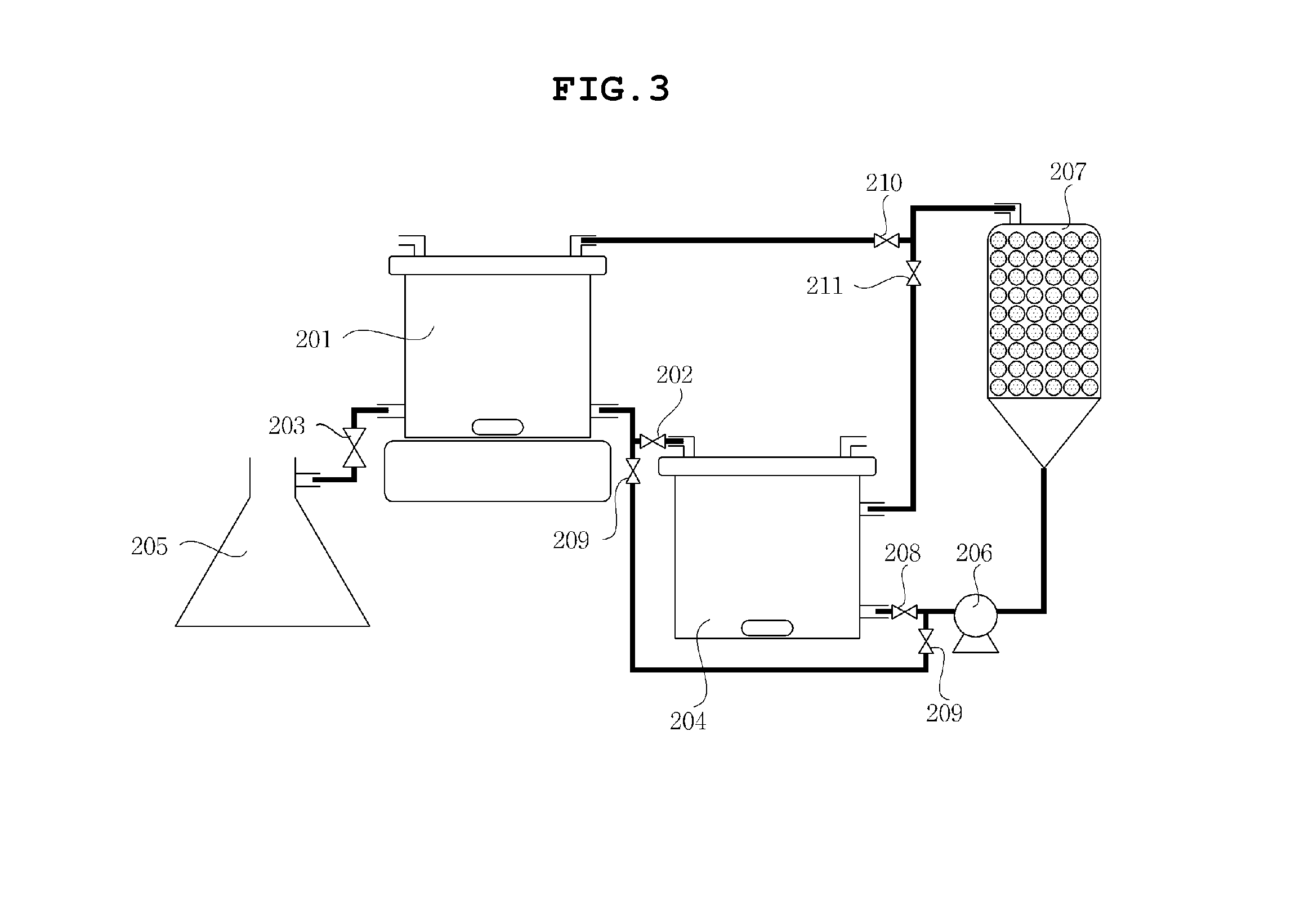Treatment method for spent caustic soda
a treatment method and technology of spent caustic soda, applied in the direction of multi-stage water/sewage treatment, water/sewage treatment by oxidation, water/sewage treatment by nature, etc., can solve the problems of high operation cost, difficult to directly treat spent caustic soda solution by a general biological waste-water disposal method, and harm to the human body, etc., to achieve efficient treatment
- Summary
- Abstract
- Description
- Claims
- Application Information
AI Technical Summary
Benefits of technology
Problems solved by technology
Method used
Image
Examples
example 1
(1) Physical Properties of Caustic Soda
[0107]Spent caustic sodas used in this Example are two types of spent caustic sodas, and are produced from a KMX (Kero Merox) process licensed by Merichem and UOP. The physical properties thereof are given in Tables 3 and 4 below.
TABLE 3Temp.NaOHCODMnCODCrBOD5PhenolMercaptanSpecific(° C.)pH(wt %)(mg / L)(mg / L)(mg / L)(mg / L)(mg / L)gravity17133.526,00076,00019,5004,0001631.15
TABLE 4Temp.NaOHCODMnCODCrBOD5PhenolMercaptanSpecific(° C.)pH(wt %)(mg / L)(mg / L)(mg / L)(mg / L)(mg / L)gravity1713673,000100,50026,3007,3502311.21
(2) Materials Used in this Example as Follows
[0108]1) Sulfuric acid (Aldrich Corp, concentration: 98 w %)
[0109]2) Sodium hydroxide (Aldrich Corp, solution containing 50 wt % of sodium hydroxide, which was prepared by diluting sodium hydroxide with distilled water)
[0110]3) Hydrogen peroxide (Aldrich Corp, solution containing 33 wt % of hydrogen peroxide)
[0111]4) As an oxidation catalyst, a commercially-available spherical catalyst containing ir...
example 2
[0134]Influence of phenol concentration on oxidation reaction temperature and hydrogen peroxide injection dosage
[0135]Spent caustic soda was treated in the same manner as in Test 1 of Example 1, except that this treatment was performed while changing oxidation reaction temperature and hydrogen peroxide injection dosage. A reaction temperature before oxidation reaction is set as operation variable, and the others are set as independent variables. The concentration of phenol is measured using water analysis kit of HUMAS. When concentration of phenol is higher than about 2,000 mg / L, distilled water is added. When concentration of phenol is lower than about 2,000 mg / L, phenol solution is added. Thus, the contents of phenol in pH-adjusted spent caustic soda are regulated to about 2,000 mg / L. The contents of phenol in the finally-treated spent caustic soda are given in Tables 9 and 10 below (average value of ten times).
TABLE 9Phenol concentration (mg / L, hydrogen peroxide (aqueous solution...
example 3
Influence of Hydrogen Peroxide Injection Dosage on COD
[0138]Spent caustic soda was treated in the same manner as in Tests 1 and 2 of Example 1, except that the injection dosage of hydrogen peroxide (aqueous solution), which is an oxidant used in oxidation treatment reaction, was changed. The results thereof are given in Tables 11 and 12 below.
TABLE 11Injection dose of hydrogen peroxide1015202530354045COD (mg / L)33173134265321672256289034204590
[0139]As given in Table 11 above, it can be ascertained that the optimal injection dosage of an oxidant (hydrogen peroxide was about 25 mL based on about 700 mL of spent caustic soda. In this case, the ratio of oxidant:COD (based on weight) was about 2:1. Particularly, it is determined that COD is increased due to residual unreacted hydrogen peroxide when hydrogen peroxide is injected in an amount of more than about 25 mL.
TABLE 12Injection dose of hydrogen peroxide1015202530354045COD (mg / L)90008400790072006400590061006400
[0140]As given in Table ...
PUM
| Property | Measurement | Unit |
|---|---|---|
| pH | aaaaa | aaaaa |
| pH | aaaaa | aaaaa |
| pH | aaaaa | aaaaa |
Abstract
Description
Claims
Application Information
 Login to View More
Login to View More - R&D
- Intellectual Property
- Life Sciences
- Materials
- Tech Scout
- Unparalleled Data Quality
- Higher Quality Content
- 60% Fewer Hallucinations
Browse by: Latest US Patents, China's latest patents, Technical Efficacy Thesaurus, Application Domain, Technology Topic, Popular Technical Reports.
© 2025 PatSnap. All rights reserved.Legal|Privacy policy|Modern Slavery Act Transparency Statement|Sitemap|About US| Contact US: help@patsnap.com



